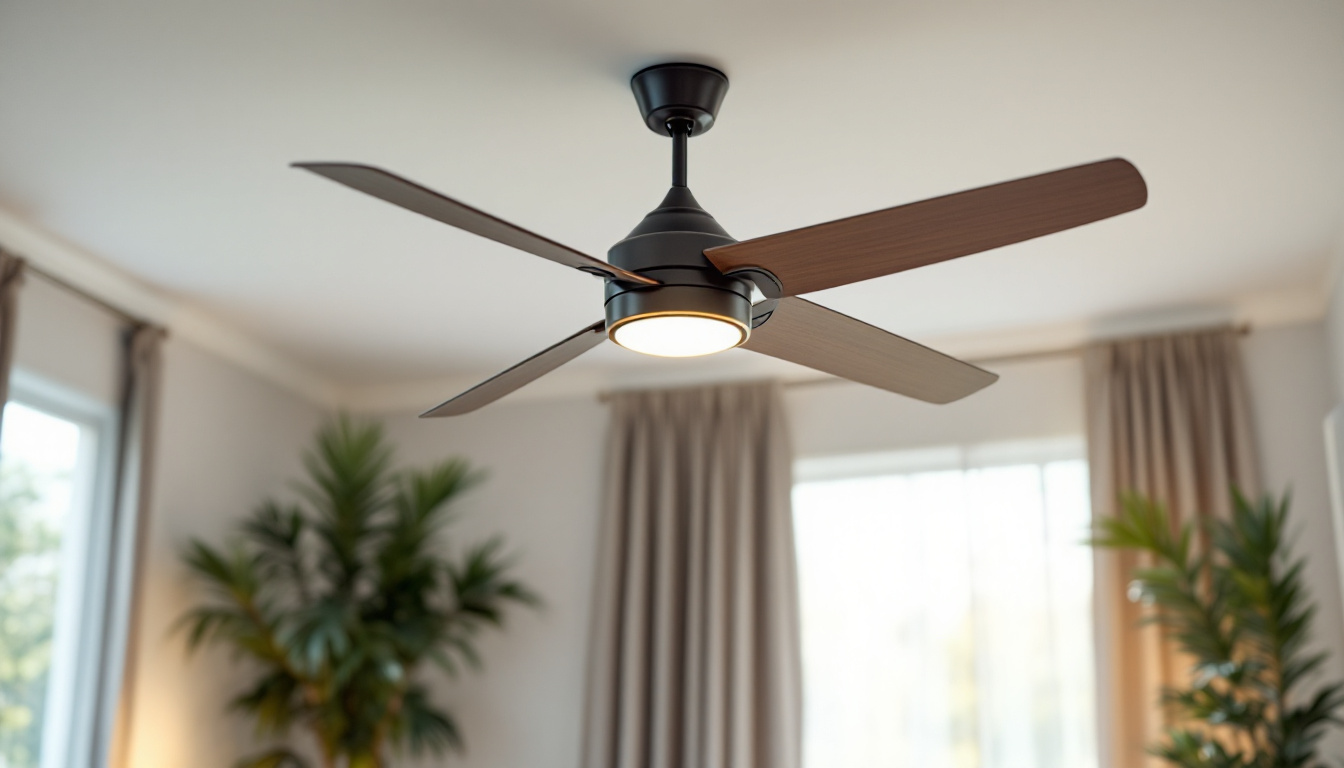
In the world of lighting and home improvement, ceiling fans often play a pivotal role in enhancing both comfort and aesthetics. As a lighting contractor, understanding the nuances of ceiling fans can significantly impact your projects and client satisfaction. With the growing popularity of ceiling fans, especially during sales events, it is essential to be well-informed about the features, benefits, and installation processes. This article delves into everything you need to know about ceiling fans, particularly during a sale.
Ceiling fans are not just decorative elements; they serve multiple functional purposes that can enhance the quality of living spaces. Understanding these benefits can help contractors recommend the right solutions to their clients.
One of the most significant advantages of ceiling fans is their energy efficiency. They circulate air throughout a room, creating a wind-chill effect that can make a space feel cooler without relying solely on air conditioning. This can lead to reduced energy consumption and lower utility bills, a selling point that resonates well with environmentally-conscious clients.
Moreover, many modern ceiling fans come with energy-efficient motors and LED lighting options, further enhancing their appeal as eco-friendly solutions. By promoting these features, contractors can position themselves as knowledgeable professionals who prioritize sustainable practices. Additionally, the use of ceiling fans can extend the lifespan of air conditioning units by allowing them to work less hard, thus saving homeowners from costly repairs and replacements in the long run.
Ceiling fans are versatile tools that can be used year-round. In the summer, they help to cool down a room, while in the winter, reversing the fan direction can circulate warm air that rises to the ceiling. This dual functionality makes ceiling fans a valuable addition to any home, allowing homeowners to maintain comfort throughout the seasons.
Contractors should educate clients on how to adjust the fan settings based on the season. This knowledge empowers homeowners to maximize their ceiling fan’s potential and enhances the contractor’s reputation for providing comprehensive solutions. Furthermore, the aesthetic variety of ceiling fans—from sleek modern designs to rustic styles—means that they can complement any interior decor, making them not only functional but also a stylish addition to a room. Homeowners can choose fans that match their personal taste while enjoying the practical benefits they offer.
With a plethora of options available, selecting the right ceiling fan for a specific space can be daunting. Contractors must consider various factors to ensure their clients make informed decisions.
The size of the ceiling fan is crucial for both aesthetic and functional reasons. A fan that is too small for a large room will struggle to circulate air effectively, while a fan that is too large can overwhelm a small space. As a rule of thumb, the fan’s diameter should correspond to the room’s size: larger fans for expansive areas and smaller fans for cozy spaces.
Additionally, the height of the ceiling plays a significant role in fan selection. For rooms with high ceilings, longer downrods may be necessary to ensure optimal airflow. Contractors should take precise measurements and provide clients with tailored recommendations based on their specific room dimensions. It’s also important to consider the fan’s placement; ideally, the blades should be positioned 8 to 9 feet above the floor for maximum efficiency. This not only enhances air circulation but also ensures safety and comfort for occupants.
A ceiling fan’s design should complement the overall aesthetic of the room. From traditional to modern styles, there is a wide variety of ceiling fans available, each offering unique finishes, blade designs, and lighting options. Contractors should encourage clients to consider the existing decor and choose fans that enhance the overall look and feel of the space.
Furthermore, the integration of smart technology in ceiling fans is becoming increasingly popular. Fans equipped with remote controls, smartphone apps, or compatibility with smart home systems provide added convenience and functionality. Highlighting these features can help contractors appeal to tech-savvy clients looking for modern solutions. Additionally, energy-efficient models that utilize LED lighting and DC motors are gaining traction, as they not only reduce electricity costs but also contribute to a more sustainable living environment. By showcasing the benefits of energy-efficient fans, contractors can position themselves as knowledgeable professionals who prioritize both style and environmental responsibility.
Proper installation is critical to the performance and longevity of ceiling fans. Contractors must be equipped with the knowledge and skills necessary to ensure a safe and effective installation. A well-installed ceiling fan not only enhances the aesthetic appeal of a room but also contributes to energy efficiency and comfort, making it a valuable addition to any home.
Before installation, it is essential to assess the electrical requirements of the ceiling fan. Most fans require a dedicated circuit, and it is crucial to ensure that the existing wiring can support the fan’s power needs. Contractors should also verify that the ceiling structure is adequate to support the weight of the fan, particularly for heavier models. Additionally, it is important to consider the fan’s energy consumption, as modern ceiling fans often come with energy-efficient motors that can significantly reduce electricity costs over time.
In some cases, additional electrical work may be necessary, such as installing a new switch or circuit breaker. Being proactive in addressing these requirements can prevent complications during installation and ensure a smooth process for both the contractor and the client. Furthermore, contractors should educate clients about the benefits of using smart ceiling fans that can be controlled via mobile apps or voice commands, providing an added layer of convenience and modernity to their living spaces.
Ceiling fans can be mounted in several ways, including flush mount, downrod mount, and angled mount. The choice of mounting option will depend on the ceiling height and the fan’s design. Flush mount fans are ideal for low ceilings, while downrod mounts are suitable for higher ceilings to ensure optimal airflow. It is also worth noting that angled mounts are specifically designed for ceilings that are sloped, allowing for proper alignment and functionality of the fan.
Contractors should be familiar with each mounting option and provide clients with guidance on which method is best suited for their specific situation. This expertise can enhance the contractor’s credibility and ensure a successful installation. Additionally, contractors may want to discuss the aesthetic implications of different mounting options, as the height and angle of the fan can influence the overall look of the room. By considering both functionality and design, contractors can help clients make informed decisions that will enhance their living spaces for years to come.
Educating clients on the importance of regular maintenance can prolong the life of ceiling fans and ensure they operate efficiently. Contractors should provide clients with practical tips for keeping their fans in optimal condition.
Dust accumulation can hinder a ceiling fan’s performance and lead to inefficient airflow. Clients should be encouraged to clean their fans regularly, especially the blades, to prevent dust buildup. A simple dusting with a microfiber cloth or a gentle vacuum can make a significant difference in the fan’s efficiency.
Additionally, contractors can recommend using a fan blade cleaner or a damp cloth for more thorough cleaning. Providing clients with easy-to-follow maintenance instructions can enhance their satisfaction and demonstrate the contractor’s commitment to quality service.
Many ceiling fans require periodic lubrication to keep the motor running smoothly. Contractors should inform clients about the importance of checking the fan’s motor and bearings for any signs of wear or damage. Regular inspections can help identify potential issues before they escalate, ensuring the fan operates efficiently and safely.
Encouraging clients to schedule routine maintenance checks can also lead to repeat business for contractors, as satisfied clients are more likely to return for future projects.
During a ceiling fan sale, contractors can leverage various strategies to maximize their sales and enhance customer engagement. Understanding the market and consumer behavior is key to a successful sales event.
Offering promotional discounts or bundled packages can attract more customers during a sale. For example, providing a discount on installation services when purchasing a ceiling fan can incentivize clients to make a purchase. Additionally, offering financing options can make higher-end fans more accessible to a broader audience.
Contractors should also consider collaborating with local retailers or manufacturers to create exclusive deals that can be marketed to clients. This not only enhances the contractor’s reputation but also fosters community relationships.
Hosting educational workshops or webinars during a ceiling fan sale can engage potential customers and position the contractor as an industry expert. These events can cover topics such as energy efficiency, fan selection, and installation tips, providing valuable information to attendees.
By offering insights and answering questions, contractors can build trust with potential clients, increasing the likelihood of future business. Providing handouts or resources during these workshops can further enhance the experience and encourage attendees to consider ceiling fans for their homes.
Ceiling fans are an essential aspect of lighting and home comfort, offering numerous benefits that can enhance living spaces. As a lighting contractor, understanding the intricacies of ceiling fans, from selection to installation and maintenance, is crucial for providing exceptional service to clients. During sales events, leveraging promotional strategies and educational opportunities can further enhance customer engagement and drive sales.
By staying informed about the latest trends and technologies in ceiling fans, contractors can position themselves as knowledgeable professionals in the industry. This not only benefits their business but also ensures that clients receive the best possible solutions for their lighting and comfort needs. Embracing the ceiling fan sale season with a comprehensive understanding of these elements can lead to successful projects and satisfied customers.
Ready to elevate your lighting projects with the finest ceiling fans on the market? Look no further than LumenWholesale, where we offer an extensive selection of top-quality, spec-grade ceiling fans at unbeatable wholesale prices. Say goodbye to local distributor markups and hello to superior products that meet the highest industry standards. With hassle-free bulk buying, free shipping, and no hidden fees, you can ensure your projects shine with reliability and high performance. Don’t miss out on the perfect blend of quality, affordability, and convenience. Wholesale Lighting at the Best Value is just a click away!

Explore the transformative journey of pole lights in parking lots, highlighting advancements in technology, energy efficiency, and design.

Discover the top challenges lighting contractors face when working with recessed lighting cans.

Discover how hiring professional lighting contractors can transform your home and elevate your business.

Illuminate your space with style! Discover expert tips from lighting contractors on selecting the perfect funky wall sconces to enhance any room’s ambiance.